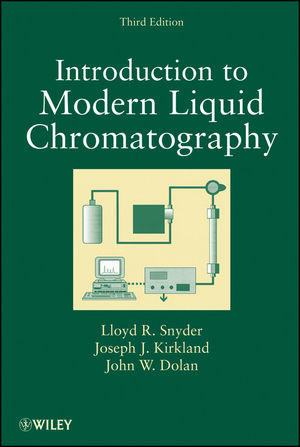|
Textbook
Introduction to Modern Liquid Chromatography, 3rd EditionISBN: 978-0-470-16754-0
Hardcover
960 pages
December 2009, ©2010
 This is a Print-on-Demand title. It will be printed specifically to fill your order. Please allow an additional 10-15 days delivery time. The book is not returnable.
|
||||||
GLOSSARY OF SYMBOLS AND ABBREVIATIONS.
1 INTRODUCTION.
1.1 Background Information.
1.2 A Short History of HPLC.
1.3 Some Alternatives to HPLC.
1.4 Other Sources of HPLC Information.
References.
2 BASIC CONCEPTS AND THE CONTROL OF SEPARATION.
2.1 Introduction.
2.2 The Chromatographic Process.
2.3 Retention.
2.4 Peak Width and the Column Plate Number N.
2.5 Resolution and Method Development.
2.6 Sample Size Effects.
2.7 RELATED TOPICS.
References.
3 EQUIPMENT.
3.1 Introduction.
3.2 Reservoirs and Solvent Filtration.
3.3 Mobile-Phase Degassing.
3.4 Tubing and Fittings.
3.5 Pumping Systems.
3.6 Autosamplers.
3.7 Column Ovens.
3.8 Data Systems.
3.9 Extra-Column Effects.
3.10 Maintenance.
References.
4 DETECTION.
4.1 Introduction.
4.2 Detector Characteristics.
4.3 Introduction to Individual Detectors.
4.4 UV-Visible Detectors.
4.5 Fluorescence Detectors.
4.6 Electrochemical (Amperometric) Detectors.
4.7 Radioactivity Detectors.
4.8 Conductivity Detectors.
4.9 Chemiluminescent Nitrogen Detector.
4.10 Chiral Detectors.
4.11 Refractive Index Detectors.
4.12 Light-Scattering Detectors.
4.13 Corona-Discharge Detector (CAD).
4.14 Mass Spectral Detectors (MS).
4.15 Other Hyphenated Detectors.
4.16 Sample Derivatization and Reaction Detectors.
References.
5 THE COLUMN.
5.1 Introduction.
5.2 Column Supports.
5.3 Stationary Phases.
5.4 Column Selectivity.
5.5 Column Hardware.
5.6 Column-Packing Methods.
5.7 Column Specifications.
5.8 Column Handling.
References.
6 REVERSED-PHASE CHROMATOGRAPHY FOR NEUTRAL SAMPLES.
6.1 Introduction.
6.2 Retention.
6.3 Selectivity.
6.4 Method Development and Strategies for Optimizing Selectivity.
6.5 Nonaqueous Reversed-Phase Chromatography (NARP).
6.6 Special Problems.
References.
7 IONIC SAMPLES: REVERSED-PHASE, ION-PAIR, AND IONEXCHANGE CHROMATOGRAPHY.
7.1 Introduction.
7.2 Acid-Base Equilibria and Reversed-Phase Retention.
7.3 Separation of Ionic Samples by Reversed-Phase Chromatography (RPC).
7.4 Ion-Pair Chromatography (IPC).
7.5 Ion-Exchange Chromatography (IEC).
References.
8 NORMAL-PHASE CHROMATOGRAPHY.
8.1 Introduction.
8.2 Retention.
8.3 Selectivity.
8.4 Method-Development Summary.
8.5 Problems in the Use of NPC.
8.6 Hydrophilic Interaction Chromatography (HILIC).
References.
9 GRADIENT ELUTION.
9.1 Introduction.
9.2 Experimental Conditions and Their Effects on Separation.
9.3 Method Development.
9.4 Large-Molecule Separations.
9.5 Other Separation Modes.
9.6 Problems.
References.
10 COMPUTER-ASSISTED METHOD DEVELOPMENT.
10.1 Introduction.
10.2 Computer-Simulation Software.
10.3 Other Method-Development Software.
10.4 Computer Simulation and Method Development.
References.
11 QUALITATIVE AND QUANTITATIVE ANALYSIS.
11.1 Introduction.
11.2 Signal Measurement.
11.3 Qualitative Analysis.
11.4 Quantitative Analysis.
11.5 Summary.
References.
12 METHOD VALIDATION.
12.1 Introduction.
12.2 Terms and Definitions.
12.3 System Suitability.
12.4 Documentation.
12.5 Validation for Different Pharmaceutical-Method Types.
12.6 Bioanalytical Methods.
12.7 Analytical Method Transfer (AMT).
12.8 Method Adjustment or Method Modification.
12.9 Quality Control and Quality Assurance.
12.10 Summary.
References.
13 BIOCHEMICAL AND SYNTHETIC POLYMER SEPARATIONS.
13.1 Biomacromolecules.
13.2 Molecular Structure and Conformation.
13.3 Special Considerations for Biomolecule HPLC.
13.4 Separation of Peptides and Proteins.
13.5 Separation of Nucleic Acids.
13.6 Separation of Carbohydrates.
13.7 Separation of Viruses.
13.8 Size-Exclusion Chromatography (SEC).
13.9 Large-Scale Purification of Large Biomolecules.
13.10 Synthetic Polymers.
References.
14 ENANTIOMER SEPARATIONS.
14.1 Introduction.
14.2 Background and Definitions.
14.3 Indirect Method.
14.4 Direct Method.
14.5 Peak Dispersion and Tailing.
14.6 Chiral Stationary Phases and Their Characteristics.
14.7 Thermodynamic Considerations.
References.
15 PREPARATIVE SEPARATIONS.
15.1 Introduction.
15.2 Equipment for Prep-LC Separation.
15.3 Isocratic Elution.
15.4 Severely Overloaded Separation.
15.5 Gradient Elution.
15.6 Production-Scale Separation.
References.
16 SAMPLE PREPARATION.
16.1 Introduction.
16.2 Types of Samples.
16.3 Preliminary Processing of Solid and Semi-Solid Samples.
16.4 Sample Preparation for Liquid Samples.
16.5 Liquid-Liquid Extraction.
16.6 Solid-Phase Extraction (SPE).
16.7 Membrane Techniques in Sample Preparation.
16.8 Sample Preparation Methods for Solid Samples.
16.9 Column-Switching.
16.10 Sample Preparation for Biochromatography.
16.11 Sample Preparation for LC-MS.
16.12 Derivatization in HPLC.
References.
17 TROUBLESHOOTING.
Quick Fix.
17.1 Introduction.
17.2 Prevention of Problems.
17.3 Problem-Isolation Strategies.
17.4 Common Symptoms of HPLC Problems.
17.5 Troubleshooting Tables.
References.
APPENDIX I. PROPERTIES OF HPLC SOLVENTS.
I.1 Solvent-Detector Compatibility.
I.1.1 UV Detection.
I.1.2 RI Detection.
I.1.3 MS Detection.
I.2 Solvent Polarity and Selectivity.
I.3 Solvent Safety.
References.
APPENDIX II. PREPARING BUFFERED MOBILE PHASES.
II.1 Sequence of Operations.
II.2 Recipes for Some Commonly Used Buffers.
Reference.
Index.



